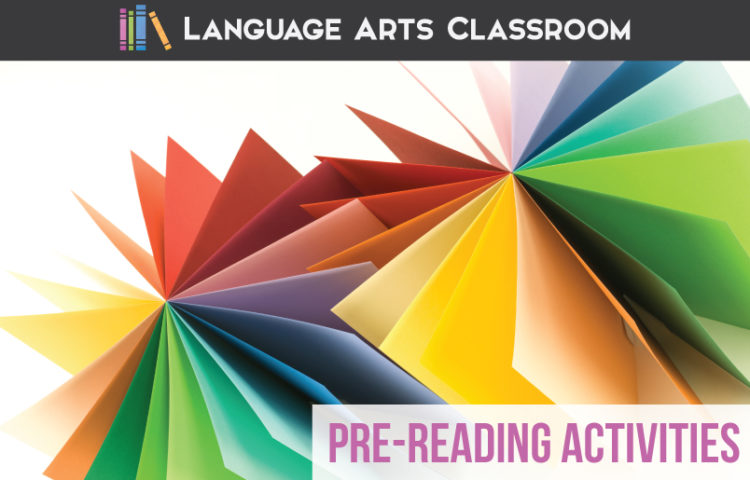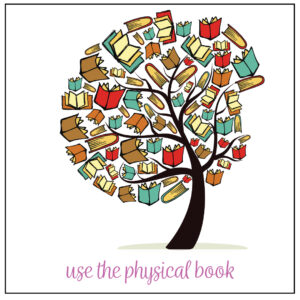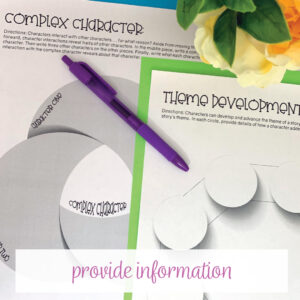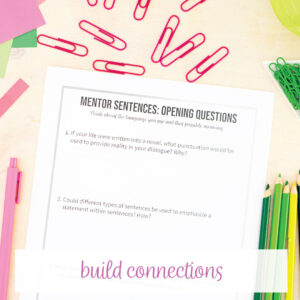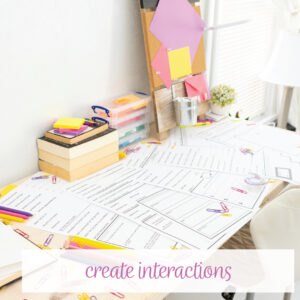Pre-reading activities for older students? Yes. These reading activities for high school students can be used with any piece of literature and build terrific anticipatory sets.
Getting students thinking about a reading assignment is paramount to their understanding and involvement of a story. When I begin with any before reading activity, I start with prior knowledge, and the term “brainstorming” helps in this situation. You might use a different term, but I often tell students we will brainstorm about the story.
Second, I explain the cognition behind our activities. I tell students that thinking about literature, pre-reading, thinking about learning, and anticipating ideas enrich students’ reading experiences will help them.
Finally, I stress to students (and myself!) that as we develop as readers, it is important to complete these “before reading activities.”
How can before reading activities boost class discussion?
A beautiful part is that if students are thinking and chatting, you are succeeding.
Hopefully, these pre-reading activities are easy to implement and can keep students (and teachers!) from getting in a rut. You can add these to any lesson plan to review or spice up a reading assignment, including watching a short video. Additionally, these ideas help students start literary analysis. (Many of these can turn into a literary analysis paragraph.)
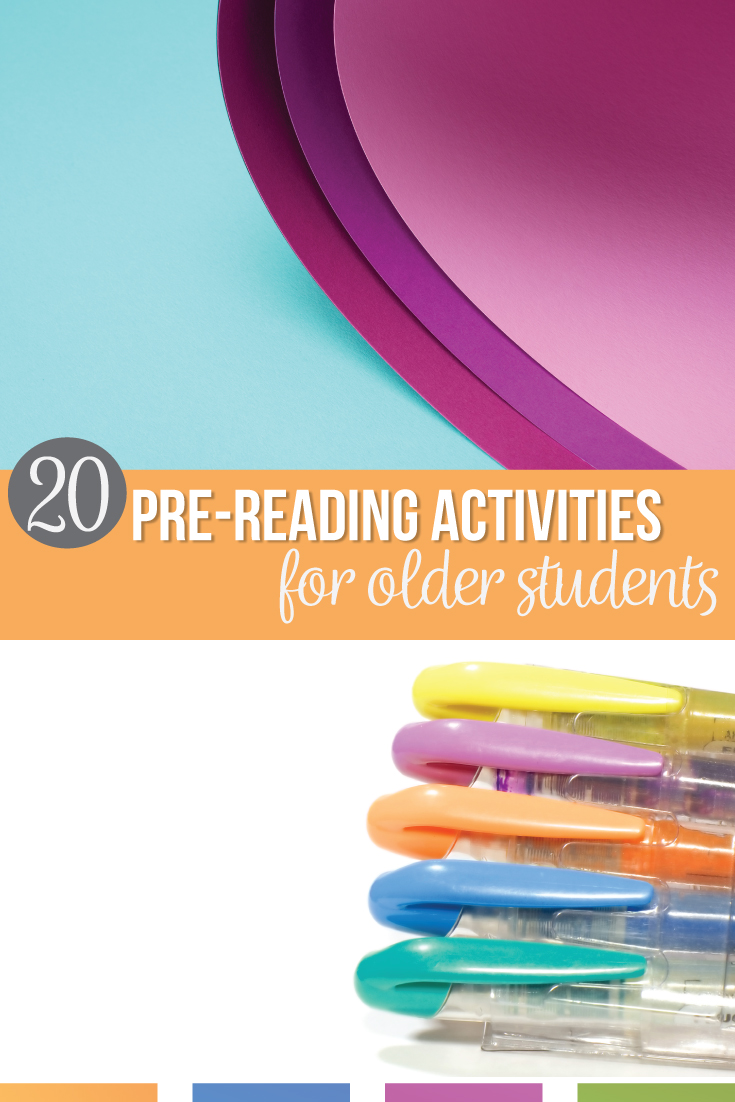
Plus? You don’t need to make these literature activities any more than what they are: A time to discuss literature, a time to end confusion, and a time of relaxed conversations with students. Part of literature is enjoying it, and with these pre-reading activities, you can cultivate a classroom where students appreciate and enjoy literature.
Additionally, students may need ‘sold’ on a novel or short story. Pre-reading activities can accomplish this and increase student understanding. I’ve compiled twenty of the pre-reading activities I’ve used with students. There are tons of variations of these, and you can personalize them for pre-reading activities for middle school or pre-reading activities for high school.
Finally, I divided these activities for pre-reading, but many of the following pre-reading examples can cross over. I hope you find them helpful and make them your own.
Use the physical book for illustrations.
Reading activities for high school can be simple—grab the book. Publishers purposefully design covers, fonts, summaries, everything. Use the book for pre-reading.
Look at the cover.
What colors are used? What images? Explain if these ideas given an inkling to the tone of the story. Do students spot a potential symbol? The colors used throughout a story might indicate pieces of the message.
Read the summary on the book jacket.
What genre are we looking at? The summary should give us a clue. Defining different types may help students understand what to expect. (Example: Animal Farm).
The book jacket is also intended to get a reader to buy or read the book. Is the book jacket persuasive? The “selling” point of a book might be on the jacket. Ask students to evaluate the effectiveness.
Look at the pictures.
Who is the story about? What does the setting look like? Sometimes the font can give the reader a clue. A romantic story may have ‘pretty’ font.
Read the table of contents.
I love finding excitingly labeled chapters. Are the chapters telling readers anything? Do they seem to follow the plot structure?
Draw conclusions from the title.
As I Lay Dying is my favorite book to do this with. Dying? For an extended period of time? We often discuss the title and what it could mean.
Provide information for learners.
Don’t be afraid to provide information before diving in with reading activities for high school. Videos, presentations, graphic organizers, and one pagers can tap prior knowledge and clarify information before students start reading.
Give students the setting.
Research ideas about the time period and location. This works well because students can find a portion that interests them: maps, fashion, politics.
Discover the genre.
Some genres require definitions. Dystopian literature, for example, contains specific details. Provide this structure for students to understand the story more.
What can the author’s background tell us?
Look at significant events in the author’s life. Would these events shape his or her writing? Edgar Allan Poe is a great author for using this technique.
For a modern take, find the author on social media. Show a few clips of the author’s life and messages.
Look at the movement.
Understanding literary movements can be challenging. Their effects and causes require extensive prior knowledge. You can build initial knowledge by defining the movement in which your literature takes place.
The Great Gatsby, for example, is a modernist piece of literature. What does modernism include? Much of modernism and realism act against romanticism, and Gatsby exemplifies that. As a class and I delve into the story, we’ll talk about modernism and Fitzgerald’s writing style. Before we read the book, we will study modernism.
Frontload information.
Some stories contain difficult concepts that students simply must understand. When students might not know a concept, event, or problem, define it and provide a timeline.
In A Raisin in the Sun, students perhaps have not studied the depths of housing discrimination. They must realize the horrors the Younger family faced and potentially faced when they moved to a white neighborhood.
The hook, the anticipatory set.
Capture students’ attentions with an interesting piece from the story. Think of revealing information about the author or startling facts about the time period.
When I teach “Marigolds,” I hand every student a marigold as they walk into the classroom. We discuss their bright color, the work of gardening, and the pleasure of flowers. Students, every year, relate to those flowers and write about them in their final assessments.
Build connections for vocabulary, comprehension, and more.
Think there isn’t a connection from your reading material to your class concepts? You can probably build a connection from a previous lesson to this new reading material.
Analyze a bit of sentence structure.
I enjoy doing this with older pieces of literature. I pull a few sentences that will not give away key parts of the story. We look at the writing with a grammatical lens. What slang is unfamiliar?
Brainstorm the central topic.
If the theme is not a secret, pre-reading activities can include developing students’ interest about a theme. For instance in The Great Gatsby, an underlying theme is that wealth is illusive and is often tied to the American Dream. Students can brainstorm about what an American Dream is, how people may have different ones, and how people attain them. They can internalize what their American Dream is, and build empathy with characters.
Research a fact.
Sometimes students read literature with which they may not be familiar. When I teach A Raisin in the Sun, I have had students complete a web quest about different types of insurance. This really pulls in students who may not typically care for plays. Learning about a ‘factual’ part of life intrigues them and can get them interested the story.
Create a web.
Pull out large pieces of butcher paper and place them around the room. Add main ideas that you’d like students to know about and let them show you what they know through illustrations. (This is perfect data for you for future lessons!) For instance, when I teach A Separate Peace, I’d create five webs for students to add details: Word War II, unreliable narrator, PTSD, friendship/loyalty, and athletics.
Create interactions.
Fun activities can be meaningful, can work toward standards, and can help with pre-reading. If students are engaged with the material before starting the reading activities for high school. . . then, they might be more engaged and more likely to enjoy reading.
Find art.
You can add art in meaningful ways to a literature lesson plan. Start with the story’s setting. Look for famous art pieces that will make the setting real to students. Music and fashion can also make the setting alive.
Play a song that people their age would have enjoyed during the time period. What games or extracurricular activities were popular? Look at beliefs, toys, and foods that were commonplace.
Use art to inspire writing. Students can write about the actual piece, or can brainstorm emotions about the art piece.
Brainstorm an element.
Whenever possible, I provide student choice for students to show me their understanding. These graphic organizers allow students to choose the best option to increase learning. If a story has intense conflict, I will provide the definition graphic organizer and complete it as we read the major conflicts.
Show a video clip.
Youtube is a wealth of information, and junk. Be aware that videos can have cuss words or present dangerous points of view.
Once you find decent videos, show clips to intrigue students, to introduce concepts. If you are looking for clean videos, check out my 2o YouTube Channels for the ELA Classroom.
Food!
Food can bring a scene or the setting alive. If a character eat something unique, bring in samples. If a type of food was common during a time period, ask students to sample it. For some students, English class will never be a favorite. That’s ok, but we should work at connecting the content in enjoyable ways. Tying food to an English lesson plan is one such way.
For instance, I taught “The Glass Menagerie” once. As part of the pre-reading, we researched the time period’s food.
One word: Spam.
The stuff in a can.
I’d never had it before, and my students loved watching my taste it for the first time. Years later, students recalled that Span was popular during the play’s time period, and they still teased me about eating Spam.
When students research the time period of Julius Caesar, they learn that a breakfast of olives, honey, and rolls was common. I’ve brought in such a breakfast for them!
Finally: Design stations
If you cannot decide what pre-reading activity to present because you found so many awesome and interesting ones, create stations. Set up your favorite pieces at individual stations, and ask students to rotate around the room. Pre-reading activities for older students bring depth to literature, and when you spend time gaining readers’ interests, building background knowledge, and designing stations, you are providing value and increasing the likelihood of student success.
Pre-reading activities for older students are important. They highlight parts of the story and bring a focus to the assignments. Plus? Pre- reading activities are a great way to neatly tie your lesson plans with a bow. After reading a novel, return to the pre- reading activities. How have students’ ideas changed? What did they correctly predict? How was the story different? All of those before reading activities, including a vocabulary preview, will better your language arts lesson plans.
What pre-reading activities for older students have you found effective? I’d love to add more to my list.
You might be interested in reading about extension activities for literature next.

